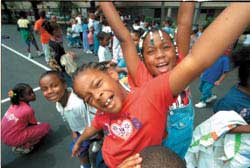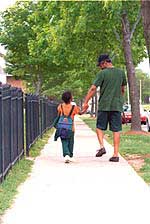![]()
ALUMNI MAGAZINE
AUGUST 1999
| FEATURES | ||
| LETTERS | ||
| AROUND TAPPAN SQUARE | ||
| A STUDENT PERSPECTIVE | ||
| HISTORIAN'S NOTEBOOK | ||
| ALUMNI NEWS | ||
| THE BEAR NECESSITIES | ||
| ONE MORE THING | ||
| STAFF BOX |
 |
|
Thanks
to Baron's efforts, these Jefferson Elementary students
in St. Louis are no longer being bused across the city.
PHOTO BY TIM PARKER
|
It wasn't always a bright picture, says Baron. "When I went to Jefferson two years ago, there wasn't a single computer in the school. The library was locked, and it was a pretty grim place. All of that has changed--it's been transformed."
Last year Baron headed a collaborative effort that raised more than $3 million to improve every aspect of the school: academics, technology, the physical plant, and parental involvement.
The firm first conducted a census of all the schoolchildren in the surrounding apartments and uncovered a bizarre vestige of the school system's 25-year desegregation effort. Four hundred neighborhood African-American children were bused to 60 public schools across the city, while 350 minority children from other areas were bused to Jefferson. Many neighborhood parents, who for years faced transportation, work, or childcare hurdles, were uninvolved in their children's distant classrooms.
With the backing of the St. Louis School Board, Baron initiated a plan to return the school to its neighborhood. Parents and local politicians, fearing gentrification and loss of local control over the school, were skeptical of Baron's motives, and he was dubbed a "plantation owner" at a contentious public meeting.
"It was very clear that if we were going to create a new community here, in an area that had been virtually devastated over the last 30 years, with an enormous loss of population, in the lowest income census tract in the metropolitan St. Louis area, we would have to address the issue of public education."
More than 300 Jefferson students now walk to school from the surrounding apartments, and school officials hope enrollment will be 100 percent neighborhood kids by next year. The school is hailed as a model for the troubled city system, and parents are enthusiastic about the changes.
 |
| PHOTO BY TIM PARKER |
Geraldine Fowler, a parent and grandparent of Jefferson students, a parent and grandparent of Jefferson students, corrects stacks of workbook pages for a teacher--she's a regular volunteer--and describes the feeling of pride people have for the school. "It's tremendously different," she says. "Kids enjoy coming to school, they have self-esteem, and they have a lot to work with." Parents are frequent visitors now, and volunteerism has greatly increased.
Jefferson Principal Dr. Ann Meese lives in Murphy Park. She is enthusiastic about her school's potential, but admits that it has a long way to go to improve academic performance. Meese echoes the need for a holistic approach to inner city challenges. "If we can accomplish our goals--stabilize our neighborhood and families and provide job training and employment with living wages--this can become a prototype for other communities."
Crawford Square in Pittsburgh. Quality Hill in Kansas City. Phoenix Place in Louisville. Just some of the 50-plus projects that Baron says are an outgrowth of Oberlin. In the 1960s, he says, the college's atmosphere was charged with "a commitment to basic humanity and a sense of honor and purposefulness"--an overwhelming optimism about changing things for the better. He recalls political science courses with former Oberlin professor Carey McWilliams which helped forge his belief in the power of community self-determination and the need for comprehensive solutions in low-income communities.
McWilliams remembers Baron well as a bright student and a caring person, recalling those years as "a high point of civic consciousness," a time when the battle for civil rights inspired many and Vietnam-era cynicism had yet to emerge.
In 1964 Baron enrolled in graduate school at Berkeley, and within a year earned a master's degree in political science. In 1968, with a JD fresh from the University of Michigan School of Law, he went to St. Louis on Reginald Heber Smith Fellowship and joined the St. Louis Legal Aid Society, followed by three years at his own law firm specializing in housing and civil rights. Within that time, he served as general counsel for the ACLU of Eastern Missouri and as an attorney and consultant with the Tenant Affairs Board of St. Louis. McCormack Baron & Associates was created in 1973.